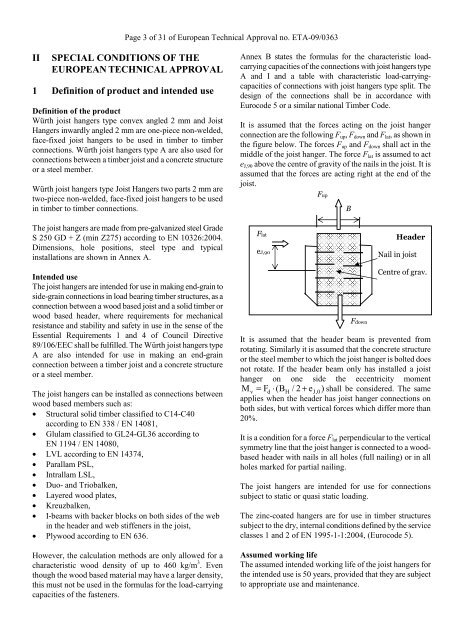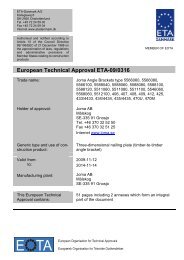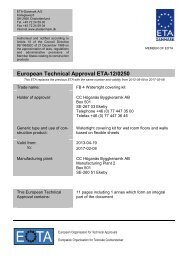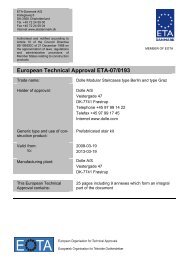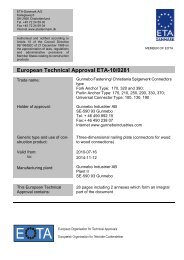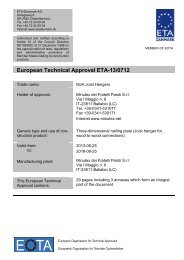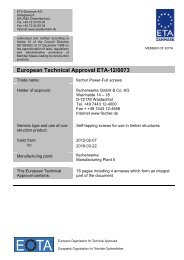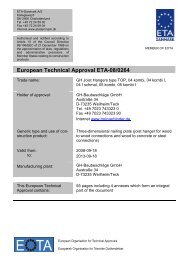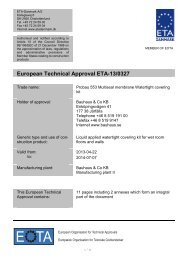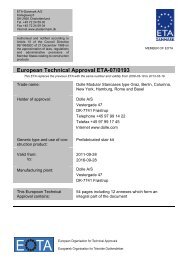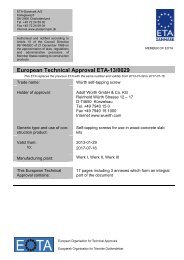European Technical Approval ETA-09/0363 - ETA-Danmark
European Technical Approval ETA-09/0363 - ETA-Danmark
European Technical Approval ETA-09/0363 - ETA-Danmark
You also want an ePaper? Increase the reach of your titles
YUMPU automatically turns print PDFs into web optimized ePapers that Google loves.
Page 3 of 31 of <strong>European</strong> <strong>Technical</strong> <strong>Approval</strong> no. <strong>ETA</strong>-<strong>09</strong>/<strong>0363</strong><br />
II SPECIAL CONDITIONS OF THE<br />
EUROPEAN TECHNICAL APPROVAL<br />
1 Definition of product and intended use<br />
Definition of the product<br />
Würth joist hangers type convex angled 2 mm and Joist<br />
Hangers inwardly angled 2 mm are one-piece non-welded,<br />
face-fixed joist hangers to be used in timber to timber<br />
connections. Würth joist hangers type A are also used for<br />
connections between a timber joist and a concrete structure<br />
or a steel member.<br />
Würth joist hangers type Joist Hangers two parts 2 mm are<br />
two-piece non-welded, face-fixed joist hangers to be used<br />
in timber to timber connections.<br />
The joist hangers are made from pre-galvanized steel Grade<br />
S 250 GD + Z (min Z275) according to EN 10326:2004.<br />
Dimensions, hole positions, steel type and typical<br />
installations are shown in Annex A.<br />
Intended use<br />
The joist hangers are intended for use in making end-grain to<br />
side-grain connections in load bearing timber structures, as a<br />
connection between a wood based joist and a solid timber or<br />
wood based header, where requirements for mechanical<br />
resistance and stability and safety in use in the sense of the<br />
Essential Requirements 1 and 4 of Council Directive<br />
89/106/EEC shall be fulfilled. The Würth joist hangers type<br />
A are also intended for use in making an end-grain<br />
connection between a timber joist and a concrete structure<br />
or a steel member.<br />
The joist hangers can be installed as connections between<br />
wood based members such as:<br />
• Structural solid timber classified to C14-C40<br />
according to EN 338 / EN 14081,<br />
• Glulam classified to GL24-GL36 according to<br />
EN 1194 / EN 14080,<br />
• LVL according to EN 14374,<br />
• Parallam PSL,<br />
• Intrallam LSL,<br />
• Duo- and Triobalken,<br />
• Layered wood plates,<br />
• Kreuzbalken,<br />
• I-beams with backer blocks on both sides of the web<br />
in the header and web stiffeners in the joist,<br />
• Plywood according to EN 636.<br />
However, the calculation methods are only allowed for a<br />
characteristic wood density of up to 460 kg/m 3 . Even<br />
though the wood based material may have a larger density,<br />
this must not be used in the formulas for the load-carrying<br />
capacities of the fasteners.<br />
Annex B states the formulas for the characteristic loadcarrying<br />
capacities of the connections with joist hangers type<br />
A and I and a table with characteristic load-carryingcapacities<br />
of connections with joist hangers type split. The<br />
design of the connections shall be in accordance with<br />
Eurocode 5 or a similar national Timber Code.<br />
It is assumed that the forces acting on the joist hanger<br />
connection are the following Fup, Fdown and Flat, as shown in<br />
the figure below. The forces Fup and Fdown shall act in the<br />
middle of the joist hanger. The force Flat is assumed to act<br />
eJ,90 above the centre of gravity of the nails in the joist. It is<br />
assumed that the forces are acting right at the end of the<br />
joist.<br />
Flat<br />
eJ,90<br />
It is assumed that the header beam is prevented from<br />
rotating. Similarly it is assumed that the concrete structure<br />
or the steel member to which the joist hanger is bolted does<br />
not rotate. If the header beam only has installed a joist<br />
hanger on one side the eccentricity moment<br />
M = F ⋅ (B / 2 + e ) shall be considered. The same<br />
v d H J,0<br />
Fup<br />
Header<br />
Nail in joist<br />
Centre of grav.<br />
applies when the header has joist hanger connections on<br />
both sides, but with vertical forces which differ more than<br />
20%.<br />
It is a condition for a force Flat perpendicular to the vertical<br />
symmetry line that the joist hanger is connected to a woodbased<br />
header with nails in all holes (full nailing) or in all<br />
holes marked for partial nailing.<br />
The joist hangers are intended for use for connections<br />
subject to static or quasi static loading.<br />
The zinc-coated hangers are for use in timber structures<br />
subject to the dry, internal conditions defined by the service<br />
classes 1 and 2 of EN 1995-1-1:2004, (Eurocode 5).<br />
Assumed working life<br />
The assumed intended working life of the joist hangers for<br />
the intended use is 50 years, provided that they are subject<br />
to appropriate use and maintenance.<br />
B<br />
Fdown


